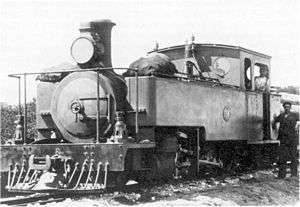CGR Type A 2-6-4T
|
CGR Type A 2-6-4T no. 31, SAR no. NG25 | |||||||||||||||||||||||||||||||||||||||||||||||||||||||||||||||
| |||||||||||||||||||||||||||||||||||||||||||||||||||||||||||||||
| |||||||||||||||||||||||||||||||||||||||||||||||||||||||||||||||
| |||||||||||||||||||||||||||||||||||||||||||||||||||||||||||||||
| |||||||||||||||||||||||||||||||||||||||||||||||||||||||||||||||
The Cape Government Railways Type A 2-6-4T of 1902 was a South African steam locomotive from the pre-Union era in the Cape of Good Hope.
In 1902, the Cape Government Railways placed two Type A 2-6-4T Adriatic type narrow gauge steam locomotives in construction service on the Avontuur branch. In 1912, these locomotives were assimilated into the South African Railways and renumbered.[1][2][3][4]
Langkloof railway
In April 1902, authority was granted for the construction of the Langkloof 2 feet (610 millimetres) narrow gauge railway from Port Elizabeth via Humansdorp to Avontuur, a total distance of 177 miles (285 kilometres). It was to become one of the most important narrow gauge railways in South Africa and passed through districts which were famous for general agriculture and the export of wheat and fruit, especially apples. The line was laid with 35 pounds per yard (17 kilograms per metre) rail and was completed to Avontuur on 10 December 1906.[2]
Coal consumption on the line averaged 54 pounds (24 kilograms) per train mile. A load from Port Elizabeth to Avontuur had to be hauled up 6,835 feet (2,083 metres) and, on the return journey, 3,963 feet (1,208 metres). This, in conjunction with the innumerable sharp curves and steep gradients of 1 in 40 (2½%) compensated, prevented a continuous high rate of speed from being attained.[2]
Manufacturer

Two 2-6-4 Adriatic type narrow gauge tank steam locomotives were supplied to the Cape Government Railways (CGR) by Manning Wardle and Company in 1902. They were designated Type A and numbered 31 and 32.[1][2][5]
It is recorded that these locomotives, during tests, were able to haul a load of 150 long tons (152 tonnes) up a 1 in 40 (2½%) grade.[2]
Service
Cape Government Railways
Both locomotives were placed in construction service on the Avontuur narrow gauge railway. At a width of 7 feet 9 inches (2,362 millimetres), they were extremely large and were the widest locomotives to see service on any of the 2 feet (610 millimetres) narrow gauge lines in South Africa.[1]
South African Railways
When the Union of South Africa was established on 31 May 1910, the three Colonial government railways (CGR, Natal Government Railways and Central South African Railways) were united under a single administration to control and administer the railways, ports and harbours of the Union. Although the South African Railways and Harbours came into existence in 1910, the actual classification and renumbering of all the rolling stock of the three constituent railways were only implemented with effect from 1 January 1912.[4][6]
The two locomotives were renumbered to NG25 and NG26 on the South African Railways (SAR), with the NG prefix identifying them as narrow gauge locomotives in the SAR registers. They remained in service on the Avontuur branch for the duration of their service lives, until they were withdrawn in 1929 without having been classified by the SAR.[1]
References
| Wikimedia Commons has media related to CGR Type A 2-6-4T. |
- 1 2 3 4 Paxton, Leith; Bourne, David (1985). Locomotives of the South African Railways (1st ed.). Cape Town: Struik. pp. 112, 156. ISBN 0869772112.
- 1 2 3 4 5 Espitalier, T.J.; Day, W.A.J. (1944). The Locomotive in South Africa - A Brief History of Railway Development. Chapter II - The Cape Government Railways (Continued). South African Railways and Harbours Magazine, April 1944. pp. 253-257.
- ↑ Dulez, Jean A. (2012). Railways of Southern Africa 150 Years (Commemorating One Hundred and Fifty Years of Railways on the Sub-Continent - Complete Motive Power Classifications and Famous Trains - 1860-2011) (1st ed.). Garden View, Johannesburg, South Africa: Vidrail Productions. p. 232. ISBN 9 780620 512282.
- 1 2 Classification of S.A.R. Engines with Renumbering Lists, issued by the Chief Mechanical Engineer's Office, Pretoria, January 1912, p. 47 (Reprinted in April 1987 by SATS Museum, R.3125-6/9/11-1000)
- ↑ Harman, Fred W. The Locomotives built by Manning Wardle & Company. Volume 3 Broad Gauge & Works List (1st ed. (undated)). Century Locoprints, Bridlington, UK. p.77. ISBN 0 9535313 2 5.
- ↑ The South African Railways - Historical Survey. Editor George Hart, Publisher Bill Hart, Sponsored by Dorbyl Ltd., Published c. 1978, p. 25.
